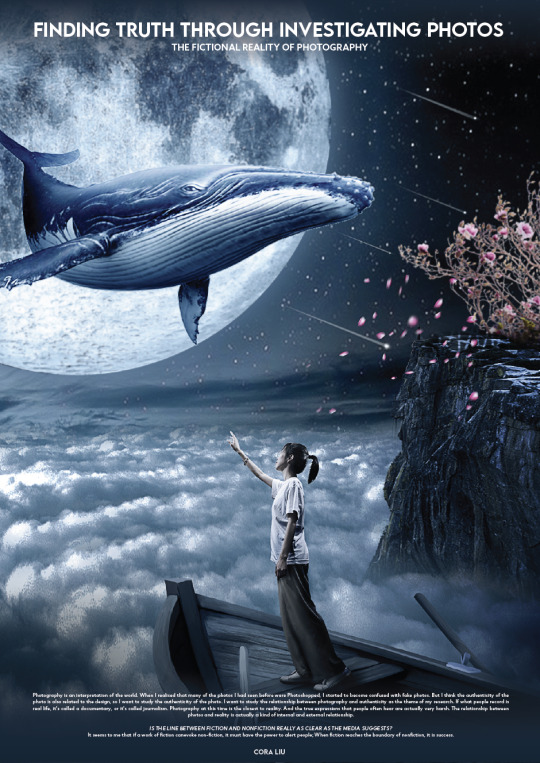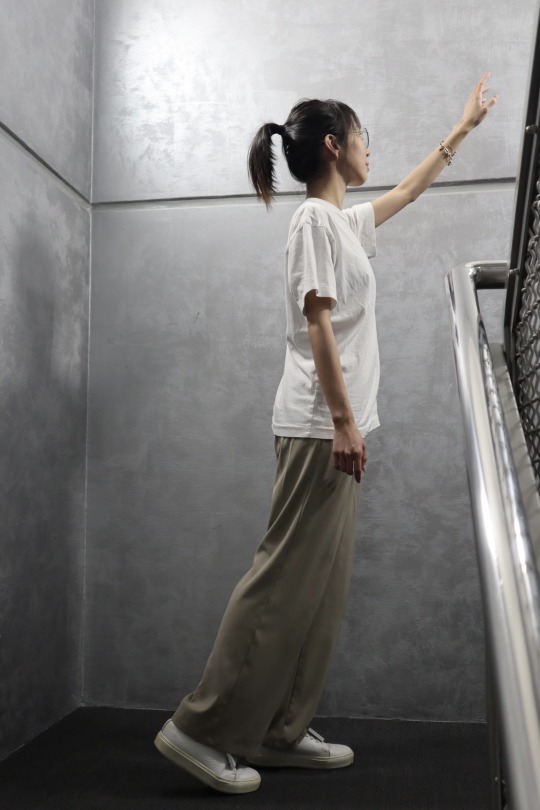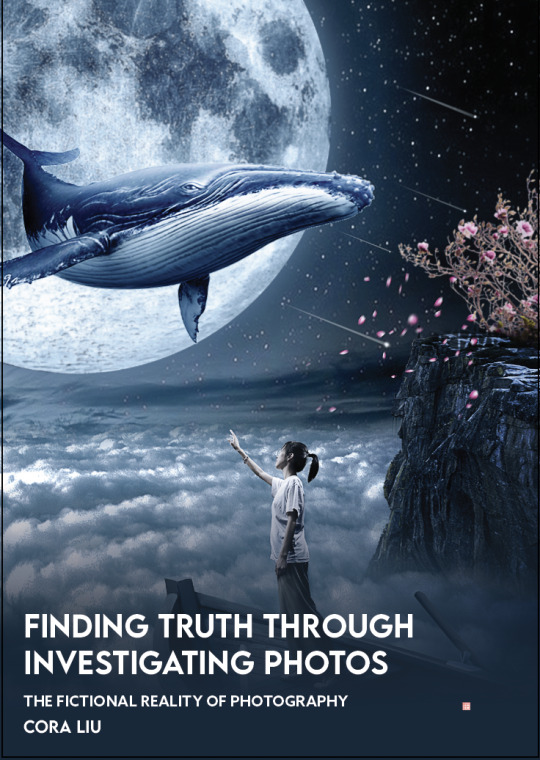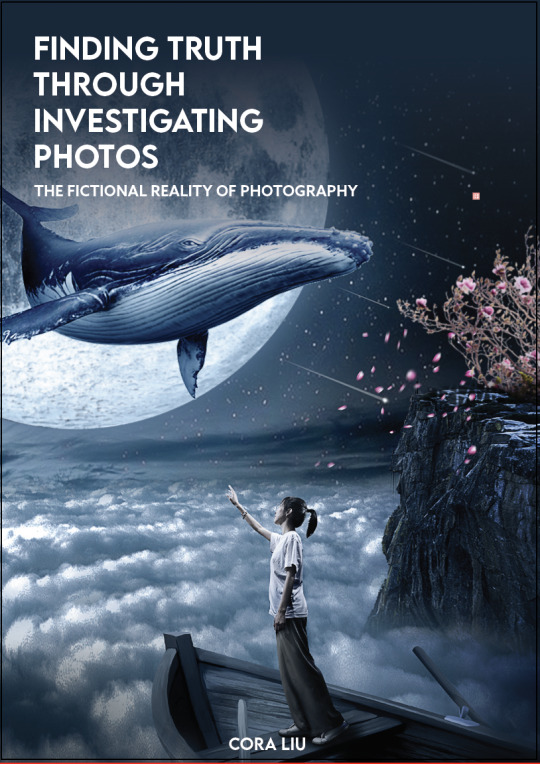Text

Final Poster
It is obviously a fiction poster, but what I want to express is there is no lines between fiction and nonfiction really as clear as the media suggests. It seems to me that if a work of fiction can evoke non-fiction, it must have the power to alert people; When fiction reaches the boundary of nonfiction, it is success.
0 notes
Text



Reference of all the elements from internets. (poster)
Photos above are my own photos for the poster.
0 notes
Text
Conclusion
Is the line between fiction and nonfiction really as clear as the media suggests? It seems to me that if a work of fiction can evoke non-fiction, it must have the power to alert people; When fiction reaches the boundary of nonfiction, it is success. Because the fictional reality is still a kind of reality, and the life of the photography work lies in this seemingly fictional reality. Just as in Yusman's photographs, multiple real negatives are superimposed on each other like a fictional illusion. It is clear that the photographic author's life is clear, or, the reason why the work gives a realistic reading experience as if he were there is that the creator of the photography must have been there, no matter what kind of "being there" he is. Such a type of photography work, which has both fictional beauty and non-fictional quality, is of course the most ideal state. To tell the truth, I've always admired photography with life as the backdrop. For if the photography is separated from the real world, the meaning of the work will disappear. Even science fiction photography, which is almost purely fictional, is bound to abide by various theories of the universe to which it must adhere.
References
Atencia, L. (2012). Fiction, nonfiction, and deceptive photographic representation. The Journal of Aesthetics and Art Criticism, 70(1), 19-30.
Fleming, J. (2020). The Twenty-First-Century Experience: Photography and Language. Afterimage: The Journal of Media Arts and Cultural Criticism, 47(3), 14-21.
Maré, E. A. (2002). The aesthetics of ideology: the vicissitudes of monuments. South African Journal of Cultural History, 16(2), 15-24.
Ryan, M. L. (2018). Photos, Facts and Fiction: Literary Texts and Mechanical Representation. COSMO: Comparative Studies in Modernism, 13, 37-50.
Seymour, L. (2018). An Analysis of Roland Barthes's The Death of the Author. Macat Library.
0 notes
Text
Review of Contextual Knowledge
Photography in the new century mainly revolves around revealing the true representation. Classic photographs often do not need words to explain, and the elements in the picture are all that the author really expresses. However, as photography has evolved to this day, the road to discovering and finding the truth, and the truth behind it, has become more daunting and fascinating. Our images can confront memory with fiction and represent real authority with fiction (Atencia, 2012). The presence of the photograph and the fiction of the text have become a conspiratorial combination, constituting a game of truth and fiction in the viewer's brain, and the conspirators use an unconventional artistic language to portray another kind of "truth" - personal subjectivity - in the post-truth era of information flooding. This decentered and multi-media integrated narrative may be more in line with 21st century expressions.
Fiction as a language of photography is not a trend, but has gradually entered the foundation of photographic art creation through the practice of many creators (Ryan, 2018). The creation of fictional images is usually a combination of photography and literature, film, video, fine art and plastic arts, and other media. The subjects of these photographs have the same qualities. Most of them have memory, history, and time as their themes, with a special focus on forgotten or lost history. The entry point of the themes is the dislocation or intersection of personal memory with public and collective memory.
The following summarizes some basic paths of photographic fiction, which, will help people to better understand the relationship between photography and reality/truth.
1. Prior literary fiction, proper narration of the background of the story and character setting. The whole group of works has been propelled by a large amount of textual narration to develop the story. The language of literary writing is used to create a virtual period and characters as a starting point.
2. Appropriation of archival science. There are two types of use, one is the selection of ready-made products with archival nature. Symbolic archival record objects are used as the carrier of the work, or a part of the work. Examples include used record books, envelopes, handwritten letterheads, old photographs, old objects, etc. The use of ready-made images such as print advertising prints, movie screenshots and web screenshots also have archival qualities. The second is the appropriation of tampered old photographs and falsification of old photographs.
3. Taking photographs. According to the characteristics of the works, the types of images with witnessing function are mostly used, such as news documentary photography, functional photography, family images, and snapshots of life.
4. Cross-border expression. The text is written visually, and the written text becomes an important part of the stylized work. The crossover of film and photography, shot in the way of film, is not limited to the way of director photography. These include the intervention and cooperation of performance art, video art, installation art, graffiti art, etc.
5. The participation of the audience. The creator induces the audience to question the authenticity of the fictional video work, and completes the work with the tension formed by the audience's doubt and belief in the truth. Under the contemporary literary concept of "the author is dead" (a viewpoint put forward by French writer Roland Barthes), the artist puts the power of creation in the hands of the viewer and interacts with them, revolutionizing the productive nature of the work of art, and the experience and repercussions of the photographic work at the viewing level directly participate in the value of the work (Seymour, 2018).
6. The creators possess the characteristics of researchers. They need to conduct in-depth research outside of art, according to the fields of natural science, sociology, history, architecture, etc. involved in the subject of the photography work, to lay a truthful and rich foundation.
0 notes
Text
Positioning the Research:
For me, I always believe that photography is a kind of elegy art. This fragmented picture recording comes from the pity for the destruction of time and the vicissitudes of history. After all, what is presented to people in the form of fragments used to be a complete life and the real past (Maré, 2002). In real fact, it is the nature of people to take words out of context, so they find pleasure in fragmentation. And it is precisely for this natural attraction, that smart and talented photographers will use to freeze their works to enlighten people. This aesthetic level obviously adds ideological components. Therefore, I hope to study the relationship between photographic photos and authenticity as the main theme of my research.
According to the line of thinking, if we record real life, it is called a documentary, or a news report. Photography at this time is the closest to reality (Fleming, 2020). Yet, sometimes, people would rather believe in a blurry picture scene taken by a person with a daily mobile phone than in a painter's vivid picture restoration. Because the painter will deliberately express the points he or she wants to present under the control of individual thoughts, while blurring or ignoring some points that he or she thinks are irrelevant, or even use exaggeration to enlarge the visual centre of gravity. But machines do not. Machines will only record faithfully. From this perspective, people often feel that photography is actually very closely related to reality, or it is a fragmented static record. It is both a faithful and a true record. However, the market for this kind of work is not optimistic, even this kind of work has material proof and timeliness. Once the timeliness has passed, or once there are stronger proof materials (such as video, high-definition cameras, witnesses), the kind of work may be further reduced.
And the real expressions that people often hear are actually very demanding. This is reflected in the truth of thought, or should be said, in the true portrayal of deep excavation and characterization through comparison. The authenticity of the photo has a breath-taking beauty. Because it is an art that comes from life and is higher than life, and it is also another kind of reality that is produced by the photographer's thoughts implanted in the process of photography. The truth is everyone has a wonderful world inside of them which may not exist in the real world. Hence the reality fixed by the photographic technique for the moment has surpassed the "reality" of truth. This exists in the highest realm that photography has to pursue. To this end, the relationship between photos and reality is actually an internal and external relationship. If authenticity is compared to the purity of the human heart, or to the content, then photography is an external carrier, which is used to carry content itself.
0 notes
Text
Positioning the Researcher:
My name is Cora. I am a relatively independent person. When I was a child, I used to stay alone and feel the bustle of Nanjing day and night. At that time, I thought it would be great if I could record it all. I remember going on holiday to the west country as a child and buying a colour postcard from a small shop in the countryside. Looking back now, the images look like a fog-stained painting, with all the figures in a soft halo that gives me an unreal feeling. It made me love the world and love life more. I would make photography a hobby in my life, showing the loveliness, confidence, and truth of life, even if I was the only viewer. Until I was 14 years old, I came to New Zealand. After I came here, by chance, I met photography. New Zealand's landscape is quite different from China's, so I often used my camera to record my life.
Over time, I became interested in photography. In this way, I see another wonderful and fascinating world. That is my interpretation of the world. I feel like I am doing an art exhibition. And when I take pictures, each scene was like a painting, one after the other (I had too much imagination). Yet I sometime sat there alone, imagining one distorted picture after another; I was never brave enough to find out the truth. I do not know what this world looks like, and sometimes I even thought, it will never be found out. But it is my world and finding the truth from pictures interests me. When I took a design class in high school, I found that many of the photos I had seen before were photoshopped. I am starting to get confused about real drinking and fake photos. But the authenticity of photos is also related to the design, so I want to study the authenticity of photos.
I have always believed that if a person is very fond of one interest, he/she will be happier when he/she makes satisfactory works. This kind of happiness is obviously happier than the happiness brought by other means. While everyone may see me differently because of some different positions. In my opinion, the pursuit of identification with others and the pursuit of personal happiness can sometimes only be one of them and not both. I think success should pay more attention to self-worth, and the pursuit of self-worth will bring inner happiness and satisfaction.
For me, I always believe that photography is a kind of elegy art. This fragmented picture recording comes from the pity for the destruction of time and the vicissitudes of history. After all, what is presented to people in the form of fragments used to be a complete life and the real past (Maré, 2002). In real fact, it is the nature of people to take words out of context, so they find pleasure in fragmentation. And it is precisely for this natural attraction, that smart and talented photographers will use to freeze their works to enlighten people. This aesthetic level obviously adds ideological components. Therefore, I hope to study the relationship between photographic photos and authenticity as the main theme of my research.
According to the line of thinking, if we record real life, it is called a documentary, or a news report. Photography at this time is the closest to reality (Fleming, 2020). Yet, sometimes, people would rather believe in a blurry picture scene taken by a person with a daily mobile phone than in a painter's vivid picture restoration. Because the painter will deliberately express the points he or she wants to present under the control of individual thoughts, while blurring or ignoring some points that he or she thinks are irrelevant, or even use exaggeration to enlarge the visual centre of gravity. But machines do not. Machines will only record faithfully. From this perspective, people often feel that photography is actually very closely related to reality, or it is a fragmented static record. It is both a faithful and a true record. However, the market for this kind of work is not optimistic, even this kind of work has material proof and timeliness. Once the timeliness has passed, or once there are stronger proof materials (such as video, high-definition cameras, witnesses), the kind of work may be further reduced.
And the real expressions that people often hear are actually very demanding. This is reflected in the truth of thought, or should be said, in the true portrayal of deep excavation and characterization through comparison. The authenticity of the photo has a breath-taking beauty. Because it is an art that comes from life and is higher than life, and it is also another kind of reality that is produced by the photographer's thoughts implanted in the process of photography. The truth is everyone has a wonderful world inside of them which may not exist in the real world. Hence the reality fixed by the photographic technique for the moment has surpassed the "reality" of truth. This exists in the highest realm that photography has to pursue. To this end, the relationship between photos and reality is actually an internal and external relationship. If authenticity is compared to the purity of the human heart, or to the content, then photography is an external carrier, which is used to carry content itself.
0 notes
Text
WIP Writing
Student Name: Cora
Title: Finding truth through investigating photos
Sub title: Photography – the fictional reality
Keywords: Photography, fake photos, authenticity of the photo, photos and reality, interpretation, form of fragments, ideological components, photographic art creation.
Positioning the Researcher
My name is Cora. I am a relatively independent person. When I was a child, I used to stay alone and feel the bustle of Nanjing day and night. At that time I thought it would be great if I could record it all. I remember going on holiday to the west country as a child and buying a colour postcard from a small shop in the countryside. Looking back now, the images look like a fog-stained painting, with all the figures in a soft halo that gives me an unreal feeling. It made me love the world and love life more. I would make photography a hobby in my life, showing the loveliness, confidence and truth of life, even if I was the only viewer. Until I was 14 years old, I came to New Zealand. After I came here, by chance, I came into contact with photography. New Zealand's landscape is very different from China's, so I often used my camera to record my life. Over time, I became interested in photography. In this way, I see another wonderful and fascinating world. That's my interpretation of the world. I feel like I'm doing an art exhibition. And when I take pictures, each scene was like a painting, one after the other (maybe I had too much imagination). Yet I sometime sat there alone, imagining one distorted picture after another; I was never brave enough to find out the truth. I don't know what this world looks like, and sometimes I even thought, it will never be found out. But it's my world, and finding the truth from pictures interests me. When I took a design class in high school, I found that many of the photos I had seen before were photoshopped. I'm starting to get confused about real drinking and fake photos. But I think the authenticity of photos is also related to the design, so I want to study the authenticity of photos.
Positioning the Research
In real fact, it is the nature of people to take words out of context, so they find pleasure in fragmentation. And it is precisely for this natural attraction, that smart and talented photographers will use to freeze their works to enlighten people. This aesthetic level obviously adds ideological components. Therefore, I hope to study the relationship between photographic photos and authenticity as the main theme of my research. According to the line of thinking, if we record real life, it is called a documentary, or a news report. Photography at this time is the closest to reality (Fleming, 2020). Yet, sometimes, people would rather believe in a blurry picture scene taken by a person with a daily mobile phone than in a painter's vivid picture restoration. Because the painter will deliberately express the points he or she wants to present under the control of individual thoughts, while blurring or ignoring some points that he or she thinks are irrelevant, or, even use exaggeration to enlarge the visual center of gravity. But machines don't. Machines will only record faithfully. From this perspective, people often feel that photography is actually very closely related to reality, or it is a fragmented static record. It is both a faithful and a true record.
And the real expressions that people often hear are actually very demanding. This is reflected in the truth of thought, or should be said, in the true portrayal of deep excavation and characterization through comparison. The authenticity of the photo has a breathtaking beauty. Because it is an art that comes from life and is higher than life, and it is also another kind of reality that is produced by the photographer's thoughts implanted in the process of photography. The truth is, everyone has a wonderful world inside of them which may not exist in the real world. Hence the reality fixed by the photographic technique for the moment has surpassed the "reality" of truth.
Review of Contextual Knowledge
Photography in the new century mainly revolves around revealing the true representation. Classic photographs often do not need words to explain, and the elements in the picture are all that the author really expresses. However, as photography has evolved to this day, the road to discovering and finding the truth, and the truth behind it, has become more daunting and fascinating. Our images can confront memory with fiction and represent real authority with fiction (Atencia, 2012). The presence of the photograph and the fiction of the text have become a conspiratorial combination, constituting a game of truth and fiction in the viewer's brain, and the conspirators use an unconventional artistic language to portray another kind of "truth" - personal subjectivity - in the post-truth era of information flooding. This decentered and multi-media integrated narrative may be more in line with 21st century expressions.
Fiction as a language of photography is not a trend, but has gradually entered the foundation of photographic art creation through the practice of many creators (Ryan, 2018). The creation of fictional images is usually a combination of photography and literature, film, video, fine art and plastic arts, and other media. The subjects of these photographs have the same qualities. Most of them have memory, history, and time as their themes, with a special focus on forgotten or lost history. The entry point of the themes is the dislocation or intersection of personal memory with public and collective memory. It seems to me that if a work of fiction can evoke non-fiction, it must have the power to alert people; When fiction reaches the boundary of nonfiction, it is success. Because the fictional reality is still a kind of reality, and the life of the photography work lies in this seemingly fictional reality. Just as in Yusman's photographs, multiple real negatives are superimposed on each other like a fictional illusion. It is clear that the photographic author's life is clear, or, the reason why the work gives a realistic reading experience as if he were there is that the creator of the photography must have been there, no matter what kind of "being there" he is. Such a type of photography work, which has both fictional beauty and non-fictional quality, is of course the most ideal state.
References
Atencia, L. (2012). Fiction, nonfiction, and deceptive photographic representation. The Journal of Aesthetics and Art Criticism, 70(1), 19-30.
Fleming, J. (2020). The Twenty-First-Century Experience: Photography and Language. Afterimage: The Journal of Media Arts and Cultural Criticism, 47(3), 14-21.
Ryan, M. L. (2018). Photos, Facts and Fiction: Literary Texts and Mechanical Representation. COSMO: Comparative Studies in Modernism, 13, 37-50.
0 notes
Text
DRAFT ABSTRACT
Student Name: Cora
Title: Finding truth through investigating photos
Sub title: Photography – the fictional reality
ABSTRACT
Photography is an interpretation of the world. When I realized that many of the photos I had seen before were Photoshopped, I started to become confused with fake photos. But I think the authenticity of the photo is also related to the design, so I want to study the authenticity of the photo. I want to study the relationship between photography and authenticity as the theme of my research. If what people record is real life, it's called a documentary, or it's called journalism. Photography at this time is the closest to reality. And the true expressions that people often hear are actually very harsh. The relationship between photos and reality is actually a kind of internal and external relationship.
Positioning the Researcher:
I would make photography a hobby in my life, showing the loveliness, confidence and truth of life, even if I was the only viewer. Until I was 14 years old, I came to New Zealand. After I came here, by chance, I came into contact with photography. New Zealand's landscape is very different from China's, so I often used my camera to record my life.
Positioning the Research:
The real expressions that people often hear are actually very demanding. This is reflected in the truth of thought, or should be said, in the true portrayal of deep excavation and characterization through comparison. The authenticity of the photo has a breathtaking beauty. Because it is an art that comes from life and is higher than life, and it is also another kind of reality that is produced by the photographer's thoughts implanted in the process of photography. Hence the reality fixed by the photographic technique for the moment has surpassed the "reality" of truth.
Review of Contextual Knowledge:
Photography in the new century mainly revolves around revealing the true representation. Classic photographs often do not need words to explain, and the elements in the picture are all that the author really expresses. However, as photography has evolved to this day, the road to discovering and finding the truth, and the truth behind it, has become more daunting and fascinating. The creation of fictional images is usually a combination of photography and literature, film, video, fine art and plastic arts, and other media. Most of them have memory, history, and time as their themes, with a special focus on forgotten or lost history. According to the characteristics of the works, the types of images with witnessing function are mostly used, such as news documentary photography, functional photography, family images, and snapshots of life.
0 notes
Text
Class exercise - Reading articles
There were many techniques during the time past. There are some technologies that people don't like at first. But as the decade went on, people gradually found that the combination of new and old technology made the design better.
Linking to my theme, I explore the authenticity of photographs. Like this article, people were reluctant to accept Photoshop photos at first because they didn't think it was real. But as time went by, people found that the moment that could not be captured in time, through Photoshop photos can better reflect the emotion of the moment. So now people are using a combination of old and new technologies.
Just like the sentence in the article “An emerging trend is the use of high and low tech together, of blending media and technologies to create hybrid works.” It expresses my topic and links to this article very well.
0 notes
Text
Research - Example Annotation
Pictures or It Didn’t Happen: Photo-nostalgia, iPhoneography and the Representation of Everyday Life
Mike Chopra-Gant
In this article, Mike Chopra-Gant tries to apply Jameson’s assertion about the rise of the faux-vintage photo as “nostalgia for the present” to explain the practice of digital photography of users. Jameson’s argument usually brings people more reflections to examine the digital imaging technology that can be used to show the materialism and authenticity of smartphone photography, particularly when the retro effect is widely used in smartphone photography while making people think of how such a form of nostalgia can present their sense of identity and ideas about an aura of pastness through elements of imaginary. To a large extent, nostalgia is more than a simple positive disposition toward the past, but it embodies the feelings and emotions of people. That’s why people can feel happy and nostalgic when they go back to the Instagram feed or Facebook photographs that they posted in the past. In this sense, such kinds of digital photography can dissolve the conceptual boundaries between the past, present, and future, so that all can mix. In the fragments of past time, all exist but there is no logical narrative, which also makes the linear narrative meaningful in such a kind of historical sense. Therefore, Jameson’s assertion brings people more explanations for the unrelated snapshots on social media while attracting people to create the photographic style of the past.
Reference:https://canvas.aut.ac.nz/courses/7942/pages/week-3-overview?module_item_id=224935
0 notes
Text
Research - Example Annotation
POST-PHOTOGRAPHY, OR ARE WE PAST PHOTOGRAPHY? ANDREIA ALVES DE OLIVEIRA
Post-photography as the author identifies has been transformed by computing and the Internet making the photographs can be easily seen worldwide without limits of time and space. Thus, when people view photographs in the digital environment, they should consider the new visual regime by strengthening the connection between digital photography and technology-based modernism and clarify their goals of the object of photographic studies in response to the dynamics of post-photography. I think that as post-photography in a digital environment provides people with more conveniences, people also can explain digital photography by referring to the photographers’ subjective feelings, techniques, and objective elements like social environment so that they can easily know how people manipulate the photographs as they wish. Indeed, when people argue about the absence of truth in photography, they also should know the absence of truth is an inescapable fact of the photographs, which requires people to how culture shapes photography when seeking the truth value of the photography.
Reference:https://repositorio.ul.pt/bitstream/10451/27744/2/Postscreen_p68-75.pdf
0 notes
Text
Research - Example Annotation
Name of the article: <A Brief History of Photography and Truth>
What is the text about? The essay focuses on photography as an important medium has always been struggling with truth.
Where is it from? International Festival of Photography
When was it published? 28.10.2022
Who is the author? Louis-Jacques-Mandé Daguerre
Why is this author worth checking out? Because the author explores the perceptions of photographic authenticity in different eras
How might the text align with your design research? The point of this article is to agree that photographs can be manipulated, in line with my point of view. Through research, I also want to demonstrate that more and more photos are now being manipulated.
Photography as an important medium has always been struggling with truth. Catlin Langford talks about the relationship between photography and truth by recalling the history of photography ranging from the release of the Kodak No. 1 camera to the Cottingley fairness to the technical creation of famous photographers like Dorothea Lange and Joseph Stain and so on. She mainly argues that people should understand although the apparent reality is inherent to the medium of photography, the supposed truth is manipulated by photographers aiming for propaganda purposes, commercial results, ideological infiltration, and so on. In order to support her argument, she well organizes her thoughts to illustrate her ideas of truth in photography from the aspects of colorful realities, staging truth and interpretation and manipulation, which encourages people to understand the role of photography in truth making while critically thinking of the realism in photography. For example, the invention of color photography makes people easily persuaded as compared with black and white photographs, they can have a realistic vision of the world to make what they see more honest and truthful. But the invention of realistic color photography in 1904 is for commercial gains. Even when talking about the staging truth, she also holds the opinion that by removing and doctoring photographs, people can rewrite historical records truth to make people alter their opinions about certain history. More importantly, people also should consider the subjective opinions of photographers to know how a photograph is framed and read as photographs are not a mechanical record but are framed by photographers.
Reference: https://photo.org.au/channel/a-brief-history-of-photography-and-truth

0 notes





